Hicks Crew – Assigned 752nd Squadron – November 18, 1944

(Photo: Joe Sirotnak)
Interned in Sweden January 17, 1945 – MACR 11730
| Rank | Name | Serial # | Crew Position | Date | Status | Comments |
|---|---|---|---|---|---|---|
| 2Lt | Roger F Hicks | 0720673 | Pilot | 17-Jan-45 | INT | Interned - Sweden |
| F/O | Joseph M Sirotnak | T3974 | Co-pilot | 17-Jan-45 | INT | Interned - Sweden |
| F/O | William H Haslauer | T129443 | Navigator | 17-Jan-45 | INT | Interned - Sweden |
| Sgt | John Berdar, Jr | 33416035 | Radio Operator | 17-Jan-45 | INT | Interned - Sweden |
| Sgt | Edward L Quarford | 36402992 | Flight Engineer | 17-Jan-45 | INT | Interned - Sweden |
| Sgt | Milton W Bennett, Jr | 35299787 | Aerial Gunner | 17-Jan-45 | INT | Interned - Sweden |
| Sgt | Robert C Birmingham | 16193373 | Aerial Gunner | 17-Jan-45 | INT | Interned - Sweden |
| Sgt | Robert I Schauseil | 11136364 | Aerial Gunner | 17-Jan-45 | INT | Interned - Sweden |
| Sgt | Robert E Betz | 12175112 | Armorer-Gunner | 17-Jan-45 | INT | Interned - Sweden |
The Hicks’ crew was assigned to the 458th in late November 1944. Their first mission to Hanau, Germany was on December 11th. They flew on Christmas Eve 1944, when the Eighth Air Force put over 2,000 heavy bombers and their fighter escorts in the air, striking airfields and communications centers in western Germany. The 458th lost one B-24 on this date, 1Lt Charles Giesen’s crew from the 752nd Squadron. Hicks and crew flew one more mission in December and three in January before their last on January 17th.
On that morning, S/Sgt Robert F. Brittain, radar counter measures operator (RCM) was assigned to fly with Hicks. He was originally assigned on July 20, 1944 as a gunner on 2Lt Robert B. Lehr’s crew. He was reclassified on November 8, 1944 as an RCM operator (MOS 866). It is not known how many missions he flew in this capacity.
While on the bomb run, their aircraft sustained flak hits which knocked out their intercom, damaged electrical and hydraulic lines, and put a hole through a fuel tank causing a major gasoline leak. The crew was forced to leave formation and head for Sweden. Flying over the Baltic Sea brought tense moments for the crew until land was spotted. They had planned to bring the aircraft in on her belly, but at 4000 feet all four engines quit, starved of gasoline. The crew bailed out and were informed that they were in Sweden, where they were to remain until the war ended in May 1945.
There is a very nice tribute page to this crew at the website, Forced Landing Collection.
Missions
| Date | Target | 458th Msn | Pilot Msn | Serial | RCL | Sqdn | A/C Msn | A/C Name | Comments |
|---|---|---|---|---|---|---|---|---|---|
| 11-Dec-44 | HANAU | 155 | 1 | 41-29352 | K | 7V | 61 | WOLVE'S LAIR | |
| 24-Dec-44 | SCHONECKEN | 157 | ABT | 41-29340 | N | 7V | -- | YANKEE BUZZ BOMB | ALL 4 GENERATORS INOP |
| 28-Dec-44 | ST. WENDEL | 160 | ABT | 41-29352 | K | 7V | -- | WOLVE'S LAIR | ABORT - NO DETAILS |
| 01-Jan-45 | KOBLENZ | 163 | 3 | 41-29340 | N | 7V | 57 | YANKEE BUZZ BOMB | |
| 02-Jan-45 | REMAGEN | 164 | 4 | 42-95018 | J | Z5 | 66 | OLD DOC'S YACHT | |
| 03-Jan-45 | NEUNKIRCHEN | 165 | 5 | 44-40283 | I | J4 | 28 | LASSIE COME HOME | |
| 16-Jan-45 | MAGDEBURG | 171 | MSHL | -- | -- | -- | -- | MARSHALING CHIEF | |
| 17-Jan-45 | HARBURG | 172 | 6 | 41-28963 | T | 7V | 17 | UNKNOWN 007 | BAILED OUT FALKENBURG, SWE |
Statements from MACR 11730
17. REMARKS OR EYEWITNESS STATEMENTS
Lt BOERS reports A/C left formation at 5355N – 0930E for Denmark, the trouble uncertain.
Lt GRICE reports heard over the VHF asking for fighter support. Flak hit in gas tank and gasoline streaming out. The time was 1245, 5348N – 1013E, possibly heading for Sweden.
Lt HAYNES reports Lt HICKS left the formation at 1249, 15 miles north of Hamburg. #3 engine feathered and fire in the bomb-bay and losing gasoline, heading for Sweden.
Lt HOFFMAN reports HICKS had #3 engine feathered at 1309 position 5407N – 0920E. He turned off to the right at this point.
Captain LOCKRIDGE reports at 1256 saw a B-24 head for Sweden, low on gas, engine out and smoking.
Lt O’REGAN reports HICKS started for Sweden but doesn’t believe he made it for the fighters came back too soon. He left formation just before leaving the coast on the way out.
Lt FERRIEL reports HICKS had a gas leak, claimed he had 20 minutes gas left. Probably did not make Sweden.
————————-
Is This Sweden?
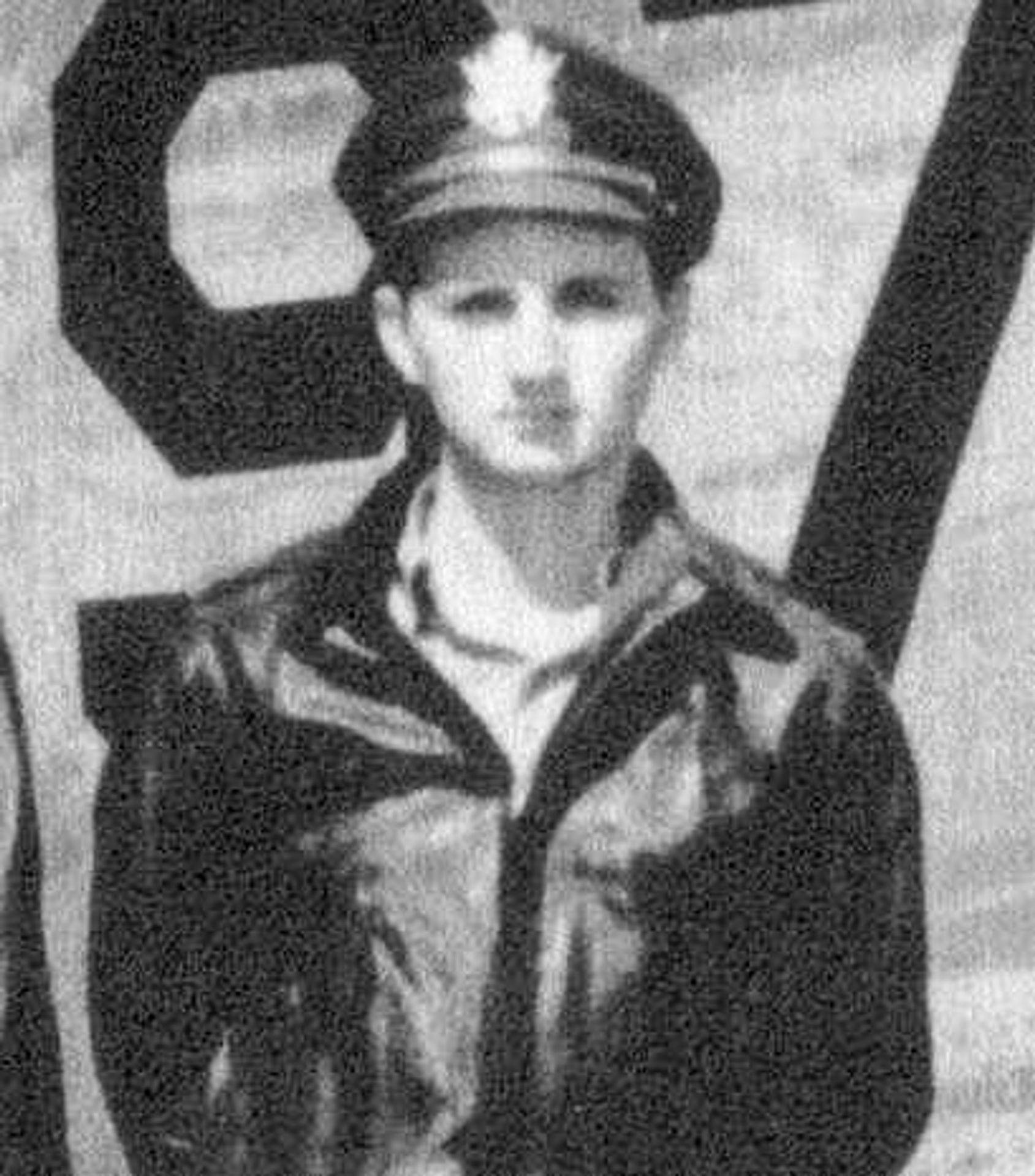
On January 17, 1945, the 458th Bomb Group participated in an attack on one of Nazi Germany’s last remaining oil refinery facilities at Harburg just south of Hamburg. Our Liberator was in formation position with the 752nd squadron flying in the lower slot.
I was flying in the co-pilot’s seat on our fifth mission. We were briefed that we would be facing about 1000 flak guns coming over and leaving the target. Yet, nothing, not even our previous missions, had prepared us for the sight of hundreds of black bursts all around us filling the sky.
We made it over the IP and then headed down the chute on our bomb run. The bomb bay doors were opened and we prepared to pull the trigger upon the release of the lead ship. The drop came and we let go – “bombs away”. Immediately, just ahead of us, and at the same level, there was a black burst. Then another, so close that we flew through the smoke. But then the ship shuddered, and we knew that we had been hit. Roger Hicks had the stick while I tried to raise someone on the intercom. There was no answer. The intercom was dead. After a few moments, the engineer, Eddie Quarford, arrived on the flight deck. He advised that we have taken a direct hit in the bomb bay.
The shell entered the still-open bomb bay doors on the right side severing the electrical, communication and hydraulic lines. It then went on through the fuel tank leaving a gaping hole through which poured a stream of 100 octane gasoline. Eddie reported that the waist areas were completely saturated with fuel. He pointed to the legs of his flying suit which were soaked in gasoline almost to his knees. Our radio operator, John Berdar came into the cockpit and we told him and Eddie to go back into the waist to warn all hands of the tremendous fire hazard.
In the meantime, we noticed a severe loss of power in the No. 4 engine. It was putting out about half of the normal inches. While we were tinkering with this problem, the oil pressure on the No. 3 engine began dropping, and we were forced to feather. Eddie returned and advised that he could see flak damage on the No. 4 engine and that the supercharger assembly appeared to have been knocked off. This explained the loss of power.
We were now rapidly falling behind our element so we got on the radio. “Lincoln Green Leader, this is Q for Queen. We have a direct hit in the bomb bay. We have No. 3 engine feathered, and we are drawing about half power from No. 4. We are falling behind the formation. Request fighter cover until we can study our situation.”
“Roger, Q for Queen, we are calling in a couple of Mustangs to baby sit.” In a short time, a flight of three P-51’s appeared, and kept us in sight off to our left. We had lost some altitude, and it was just about sure that we would lose more. We sent Eddie into the back of the ship again to have the crew start jettisoning equipment to see if we could maintain altitude. Since, obviously, we could not fire the guns anyway, they were the first things to go over the side. They were followed by anything that could be dismantled or torn loose. We continued to lose altitude and the distance between us and the group lengthened to the point where we could hardly see them anymore.
“Q for Queen, this is Lincoln Green Leader. Your escort will have to leave because of fuel considerations. What is your situation?”
“Roger, Lincoln Green Leader, we are continuing to lose altitude slowly. We estimate that we have lost half our fuel. The cross feed system is working, and we are able to keep three engines turning.”
We decided it was time for a meeting with our navigator, Bill Haslauer. He reminded us that we were briefed for extremely heavy headwinds for the return trip – possibly up to 100 mph at the higher altitudes. He did some calculations and estimated that we had about 45 minutes of fuel left. Certainly, it would not be possible to make it back to England. We were aware that a dunk in the North Sea in January would be fatal. We decided to make a try for Sweden.
Unfortunately, Bill’s maps did not go beyond the northern part of Germany. Roger Hicks thought the heading ought to be about 15°. I voted for a heading of 35°. Bill suggested a compromise so we turned to a heading of 25°.
“Lincoln Green Leader, this is Q for Queen. We do not have sufficient fuel to make it back to base. We are going to head north and hope for the best.”
“Roger, Q for Queen. We read you. Good luck!”
We turned into a 25° heading while we struggled to keep our loss of altitude to a minimum. We told Eddie to continue his efforts to lighten the ship. This meant throwing over any radio equipment that could be detached, dropping the ball turret, getting rid of flak suits, and anything else that did not have an immediate essential use. We were now able to slow our descent to about 200 feet per minute. However, this required all the extra power we could give the No. 1 and No. 2 engines since No. 3 was feathered and No. 4 was only giving us half our money’s worth. This was making the port engines run hot.
Now, we spotted two Luftwaffe aircraft, but they were below us. For some reason, they did not climb to meet us. As we passed over various built-up areas, bursts of flak appeared around us. We were passing over the north German coastline, and we could see the sea below us. The situation looked grim. We had no way of estimating how far we would have to go before reaching a landfall. The ship was saturated with gasoline. There were hundreds of flak holes in the wings and body of the aircraft which added to the drag. We continued to lose altitude. We were out of sight of land over an unfamiliar body of water.
We ran a check on everybody. The ball turret gunner, Bob Betz, and the tail gunner, Bob Birmingham had stayed in their positions after we were hit. There was some difficulty getting them out of the turrets since we had lost our hydraulic and electrical systems. Eddie Quarford did a superb job saving what fuel was not immediately lost. By using the cross feed system he was able to let us keep three engines turning with the gasoline remaining in one tank.
Bill Haslauer was the first to spot the landmass ahead. Then, we all saw it. But what was it? Denmark? Sweden? What did it matter? The gauges already hovered on the empty mark, so we decided to go in and try for a landing along the beach areas. We crossed the coastline. We were now at about 8000 feet, and we began the descent as we looked for a place to put down. At 4000 feet the engines quit. One by one, they died as the last of the fuel was sucked into their cylinders. Roger immediately ordered us to bail out. I was to go back into the waist to give the command since we had no intercom operating. As I buckled my chute, I struggled through the bomb bay to reach the opening of the waist. When I was sure that all of the crew members there had understood my signals and were moving to the floor hatch, I returned to the bomb bay catwalk to make my jump. Eddie, John Berdar, and Bill had gone, and Roger was approaching from the cockpit. I dove out headfirst.
The brief lecture we had several months before was now vividly in my mind. “After you leave the aircraft, look up to make sure you are clear of the tail.” I looked up as I tumbled through the air. I was clear of the tail. “Hold your legs tightly together, then pull the ripcord.” I held my legs tightly together. I pulled the ripcord. “Now, look down to see how high you are, and look for a landing area.” I looked down to see how high I was. I hit the ground!
Darkness. I had struck the ground so hard it knocked me out. Upon regaining consciousness I was aware of a tugging and realized that it was the billowing chute dragging me across a farmer’s plowed field. I was able to grab the lines and spill the chute. Then I took stock of my situation. My flying boots were gone. They had evidently come off when the chute popped. I was covered with mud and dirt from being dragged, and I had blood on my face. I was groggy so I sat for a few minutes. I could see a dirt road not far away, so I forced myself to my feet. Both ankles hurt, but I was able to limp the short distance to the side of the road. I could now see two figures on bicycles about half a mile away coming in my direction. They had uniforms, and they were armed with rifles slung over their backs. Although I could not recognize the uniforms, I did not think they were German. I had a .45 in a shoulder holster, but I decided not to draw it. I waited. The two soldiers approached and dismounted from their bikes. I was happy to see that they did not unsling their weapons. I pointed to the ground and asked if this was Sweden. They looked at me blankly for a few moments, and then one of them finally nodded his head while speaking in a language which was completely incomprehensible to me. But yet I understood. I was in Sweden!
In about 10 minutes, a small truck arrived and I was taken to a nearby farmhouse where a farmer’s wife gave me a hot drink and helped me to clean up. She also put a bandage over the cut on my nose. Shortly, we were back in the truck and drove for about 20 minutes until we arrived in front of the Grand Hotel in Falkenburg. There I found almost all of the crew. Roger Hicks was to turn up later. He had hidden in the forest for some time before giving himself up.
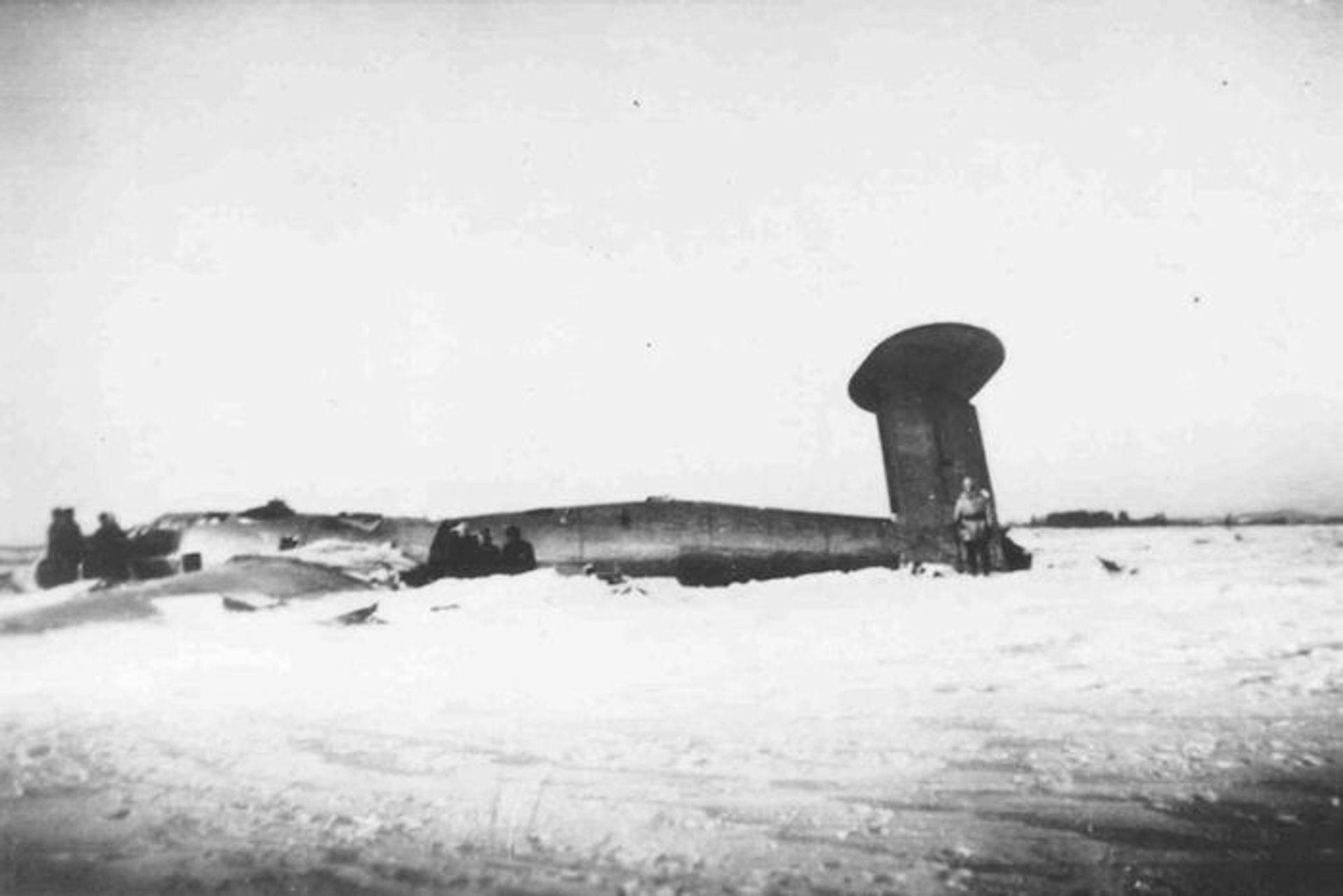
Bob Brittan, our RCM Operator, had landed on a roof and had injured his leg. The others said they had landed hard but they seemed okay. When Roger Hicks finally arrived, he was suffering from a sprained back, but he was able to walk. Bob Betz and Milt Bennett, the waist gunners, were in the best condition. No bruises, sprains, or broken bones. They didn’t bail out!
This is what happened. When it was their turn to go through the floor hatch, they decided that the ship was too low for them to jump safely. They assumed Roger and I intended to bring it in for a landing somehow. They chose to stay with us. With no one at the controls, the aircraft was now in a steep glide which enabled it to pick up substantial air speed. It leveled out at some proximity to the ground and made a beautiful belly landing in an open field. It slid along the ground strewing debris along its path, but remaining pretty much in one piece. Bob and Milt jumped out of the waist window as soon as the ship stopped moving. They ran to the front and saw that the cockpit was severely damaged. They clambered up to see if they could help us get out. They looked inside. The cockpit was empty!
We were in Sweden until after VE Day. After that we were involved in ferrying flyable Libs back to England. Perhaps in Germany there is still living a retired ex-munitions worker who in his haste assembled one 105 mm anti-aircraft shell with a defective contact fuse. “Prosit, Mein Herr!”
This story was written by Joe Sirotnak in 1980 and published in the 2nd Air Division Association Journal. It is reprinted here with the permission of the author.
B-24H-20-DT 41-28963 7V T

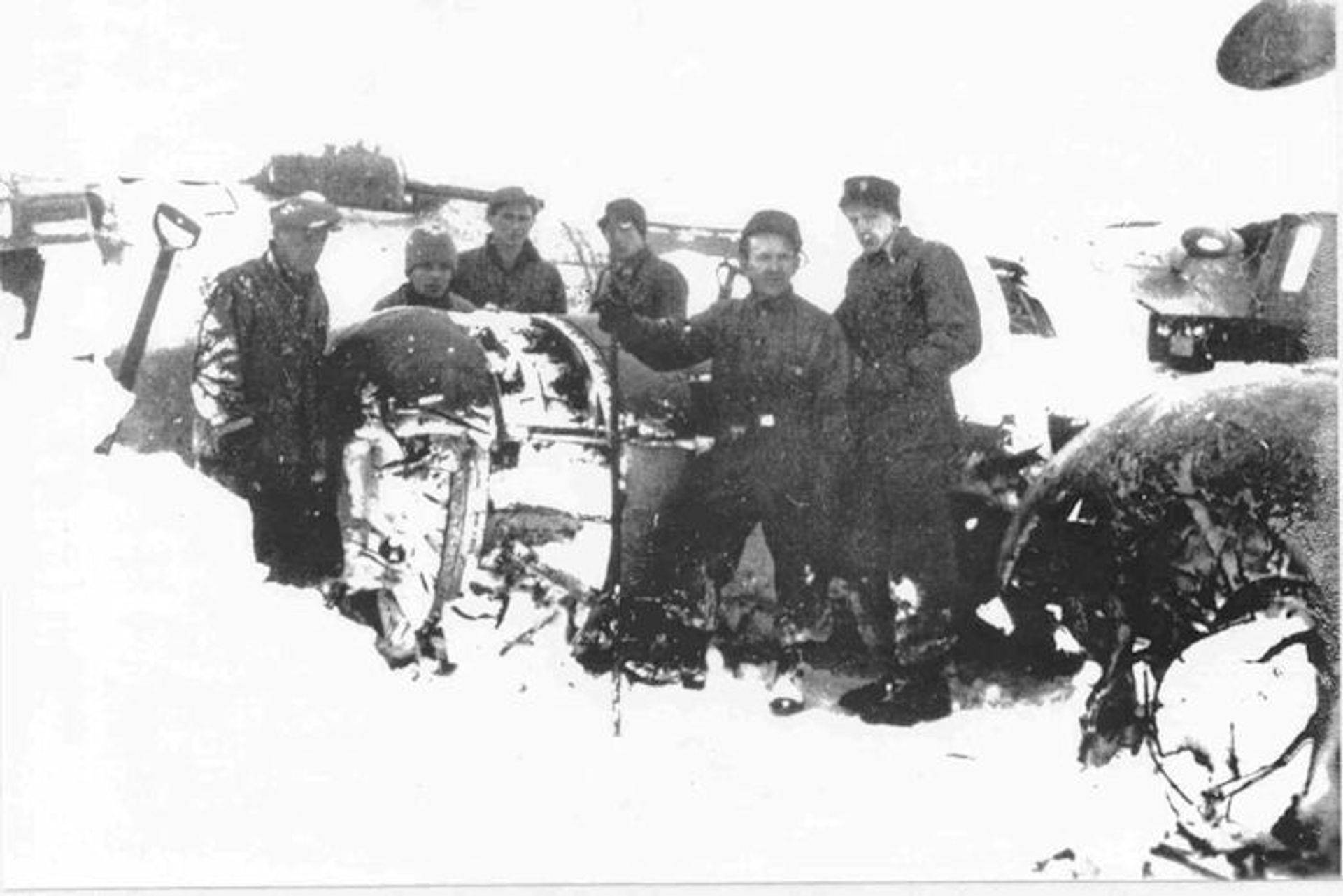
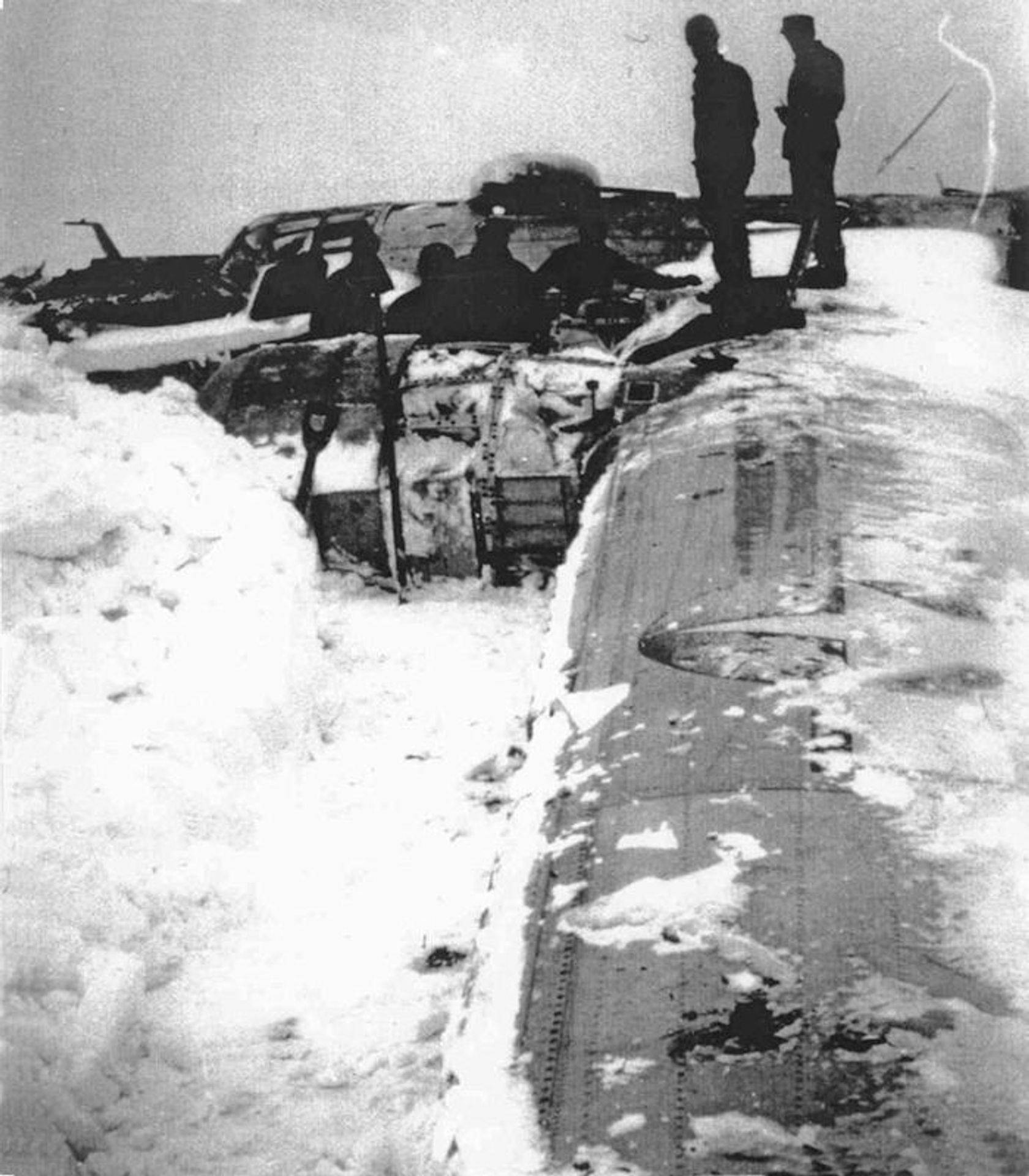
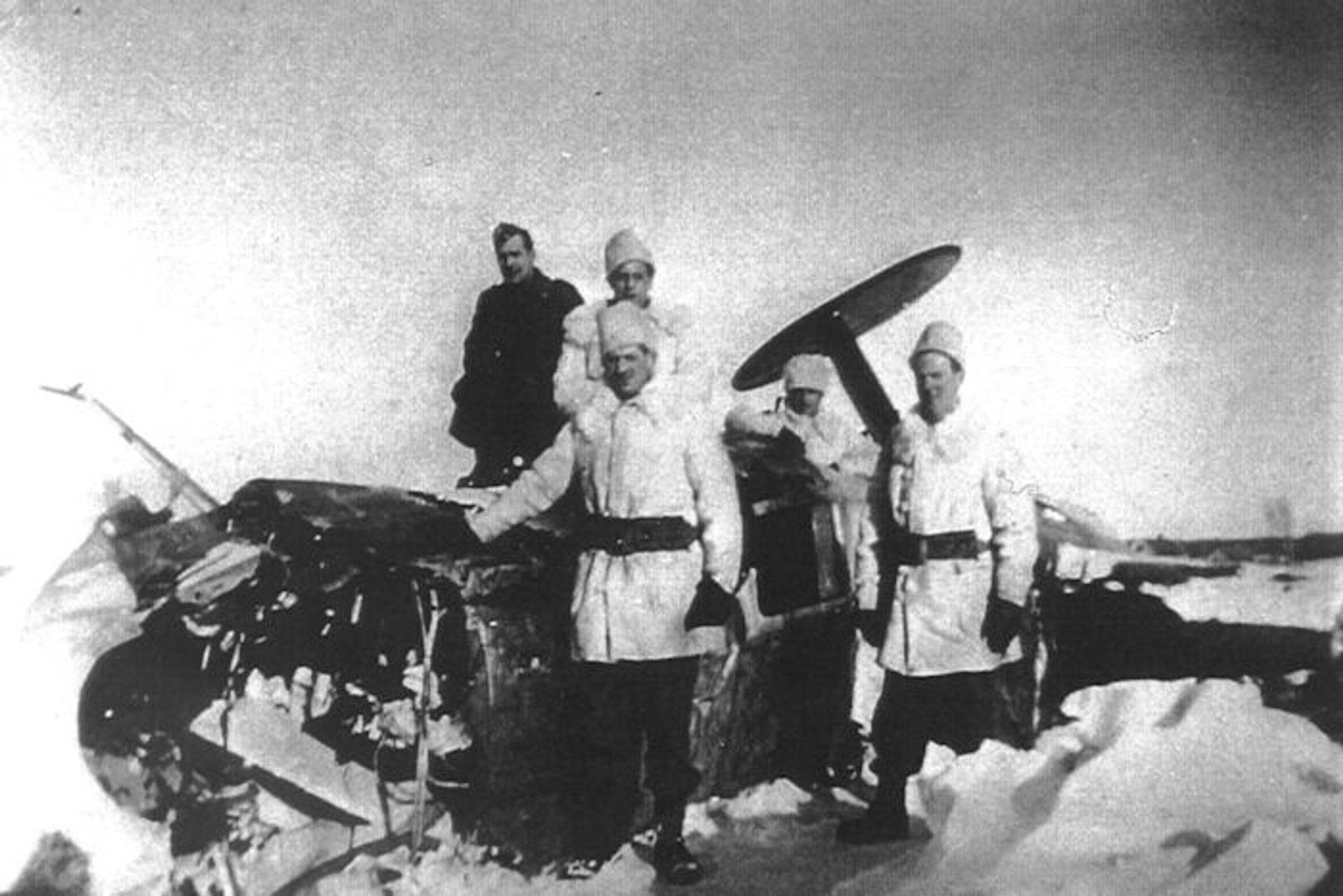
Wreckage of Hicks’ Liberator with Swedish guards
(Photos: Joe Sirotnak)
This Is Sweden?
In our last episode entitled “Is This Sweden?” we had arrived in this neutral country after a hectic flight from Germany, fleeing from a lot of angry guys after destroying their last remaining oil refinery at Harburg.
The beginning of our six months confinement in this rugged country began on January 17, 1945. Most of us had bailed out of our Liberator just after we crossed the Swedish coast. We were soon rounded up. Our “captors” incarcerated us for the first night in the Grand Hotel at Falkenburg. But first, before retiring, we had a substantial dinner at which the writer discovered how tasty fish could really be. In the morning we consumed a miniscule breakfast of cereal, eggs, cheese, toast, milk and coffee. Then we were dragged away to be put onto a train bound for a destination unknown.

“RATTVIK” – the sign at the train station read as we disembarked. We were met by a tall, handsome, mean-looking Swedish Army officer. He was most certainly a very distinguished looking individual, and he presented himself in a uniform, which was , at the very least, impeccable. This very impressive looking officer was Lt. T.E. Tistrand. “Jimmy”, [Capt Torkel Tistrand, left] as he became known to his friends and other people, escorted us to a group of taxis, which were standing at the front of the station. These vehicles all appeared to have a furnace hanging on the rear, not unlike the one my Mother had in the basement of her home. These “furnaces” were stoked with charcoal, and then the damn taxis drove off in a cloud of smoke.
Our new home was called the Hotel Turisthemmet. It was a small hotel with about 35 rooms. Roger Hicks and I were assigned to a comfortable room on the third, the top, floor – our new home for the next three months. Other rooms in the building were occupied by other men from a B-17, which had landed on the same day. A total of 21 souls, all wondering what was in store for them and especially, where they would get their next beer. The most crushing blow of all: discovery that Sweden had some type of prohibition. No booze!
Beer was available, but it contained no alcohol. Now, at last we know why they have been so nice to us up to this time. The immediate question came to everybody’s lips. Where were the bootleggers?
Rattvik is a small resort type town which had a population of about 900 in 1945. It is on the eastern shore of Lake Siljan, a rather large body of water in the middle of the country. It is both a summer and a winter resort, although at that time there were not any ski lifts. The town’s activities were centered on main street. We soon took off in the direction of the action.
Klingberg’s Konditori, a coffee shop and bakery of the first order, was the target. We homed in on those pastries like guided missiles, and once again all was right with the world. Martin Klingberg and his family were delighted to see us, and we were delighted to see his baked goodies. We had found our foster home.

(Photo: Joe Sirotnak)
As internees in a neutral country, we were required to wear civilian clothing. This required extensive shopping in the town’s only men’s wear store. I bought a cocoa brown, double-breasted suit with tan stripes, and a grass green, single-breasted suit with a black plaid design. I ought to say that I was being conservative compared to some of my fellow Americans. I have a theory that the high altitude flying gave us all some kind of brain condition which made it impossible for us to be aware of the fact that our selections were, at best, ludicrous, and worse – we all thought we looked great!
Now, what does a group of healthy, red-blooded Americans do with their time in Sweden in the middle of the winter? Well, how about skiing? You got it. So let us trudge to the local sporting goods shop. The proprietor was ecstatic. We had to buy skis, poles, boots, pants, jackets, hats and gloves for 21 confident and eager skiers, we should also now have to take into consideration we should also now have to take into consideration the consequences of 19 of these having no measurable experience. Well, it turned out that we were to avoid a plague of broken bones. However, the replacement of broken skis and poles gave a great lift to the local business environment.
Then there was “Slug”, the toughest tail gunner ever to come out of Cicero, Illinois. What we would consider to be excruciating pain was no more than an itch to Slug. He looked like he could run at the wall of a brick building and make his own door. Underneath it all, he was the kindest, sweetest person you would ever be likely to meet. This is all leading up to a description of Slug’s skiing technique. He had a singular method of getting down the hill. He would make his way to the top on his skis like the rest of us. He would push off, travel about 40 feet, and then tumble to the snow. He would clamber back to his feet, once again assume the position of attention, and shove off, after another short distance he would go down again. He would continue this routine until he reached the bottom of the slope. His progress was similar to that of a bouncing ball. He skied daily, and we had to admire his perseverance. He never changed his technique!
Slug’s indifference to pain made him the ideal tail gunner for the bobsled. This vehicle was a home made device constructed from miscellaneous debris located around the town. The main body was a heavy plank about 9 feet in length. To this were attached wooden runners with metal on their edges, stolen from the local blacksmith shop. The entire contraption weighed a considerable amount. It was steered with the use of two ropes attached to the somewhat movable front runners.
Our ski slope was mostly a straight hill that crossed some railroad tracks and then made a bend on to the main street leading through the center of town. The skiers generally slowed down after the tracks and then made their way into town. The bobsled, however, was just about reaching top speed at the rail crossing, so it was common for it to clatter through the main street at 40 or 50 miles per hour, which was at least twice the legal speed limit.
At the spot where the run crossed the tracks, the ground leveled off and then suddenly dropped away. This resulted in the sled leaving the ground for a bit and then crashing down. Invariably, the last man on the sled was thrown off. Needless to say, it was very difficult to recruit people to fly in this position. Slug loved it!
Sad to say, the reign of the bobsled was short-lived. There were some problems involving the local constabulary having to do with reckless endangerment, a broken plate glass window, and a few other minor difficulties, including disrespect and insults involving a police officer. (This is about the time we discovered that most Swedes speak and understand English very well.)
As I mentioned above, there was no legal booze available. The beer was tasty, but the alcoholic content was nil. However, faint heart never conquered, etc. so in our minds there was the vague hope that perhaps there existed in this beer some small remnants of alcohol which could be gleaned by drinking a case at a time. This theory was tested again and again with each one at the party bringing his own case of foamy brew. It was all very scientific. We can report that it did not generate any mellow feelings, nor did it generate any hangovers. It did definitely generate a lot of trips to the bathroom.
As the weather became warmer, we knew it was only a matter of time until we would have to be moving on. The war news was good, and we became increasingly aware that our days in Stalag 000 would not be many more. The skiing was still not bad, but each day more and more of the snow melted, and we went up to the hill less and less. Finally, when April arrived, we received the word. We would all be moving down to Vasteras.
At Vasteras there was a Swedish Air Force installation. It was a rather crude accommodation with one paved runway and several grassy ones. The Operations Hut was exactly that, a hut, which seemed to have been out together in a rather hurried and even haphazard fashion. However, the hotel in town was pleasant, and there was one other redeeming feature about the location. It was only about 35 miles from Stockholm. This made it easy for weekend excursions so that Scandinavian metropolis. We had discovered that wine was available in many of the restaurants.
The reason for Vasteras was that it was being used as a staging area to get the repairable Libs and Forts into flyable condition. Many of the ships which had survived their landings in Sweden were eventually brought to this field where they were worked on by American and Swedish personnel, and test flown by American pilots. We actually ended up with about two dozen aircraft in slightly better than marginal condition. With a long running start they could even get off the ground. I had a couple of these short test flights. I would rather have been back in the flak over Hamburg.
Our life in Vasteras was different. We had a job to go to during the day now, so playing was mostly restricted to the nighttime hours. The spring weather was delightful. There were dances in the city park on the weekends, and there was bicycling in the town and countryside. Then the war ended.
VE DAY in Stockholm! We had a party at a restaurant where we were joined by some Danish refugees, a couple of Norwegians, and assorted other people whom we never go to identify. Champagne! It flowed like water as we drank one toast after another. Why not? It meant that we would be soon going home. The uncertainty of not knowing how long we would have to remain in this rugged country far from home was now obliterated. It was all over! Let’s cut the orders and get going. But wait! It was not to be.
The leading question remains. What is to be done with the detachment of aircraft lined up in not very neat rows at Vasteras?
“Well, men, that there bunch of aircraft has to be repatriated. That means, men that they have to be gotten out of the country. In fact, men, those Libs and Forts, they have to be gotten back to England, and the only way that can happen is if somebody flies ‘em back. Now, we’re real sorry about this, but if we get real eager we ought to be able to get the job done before the summer is over.”
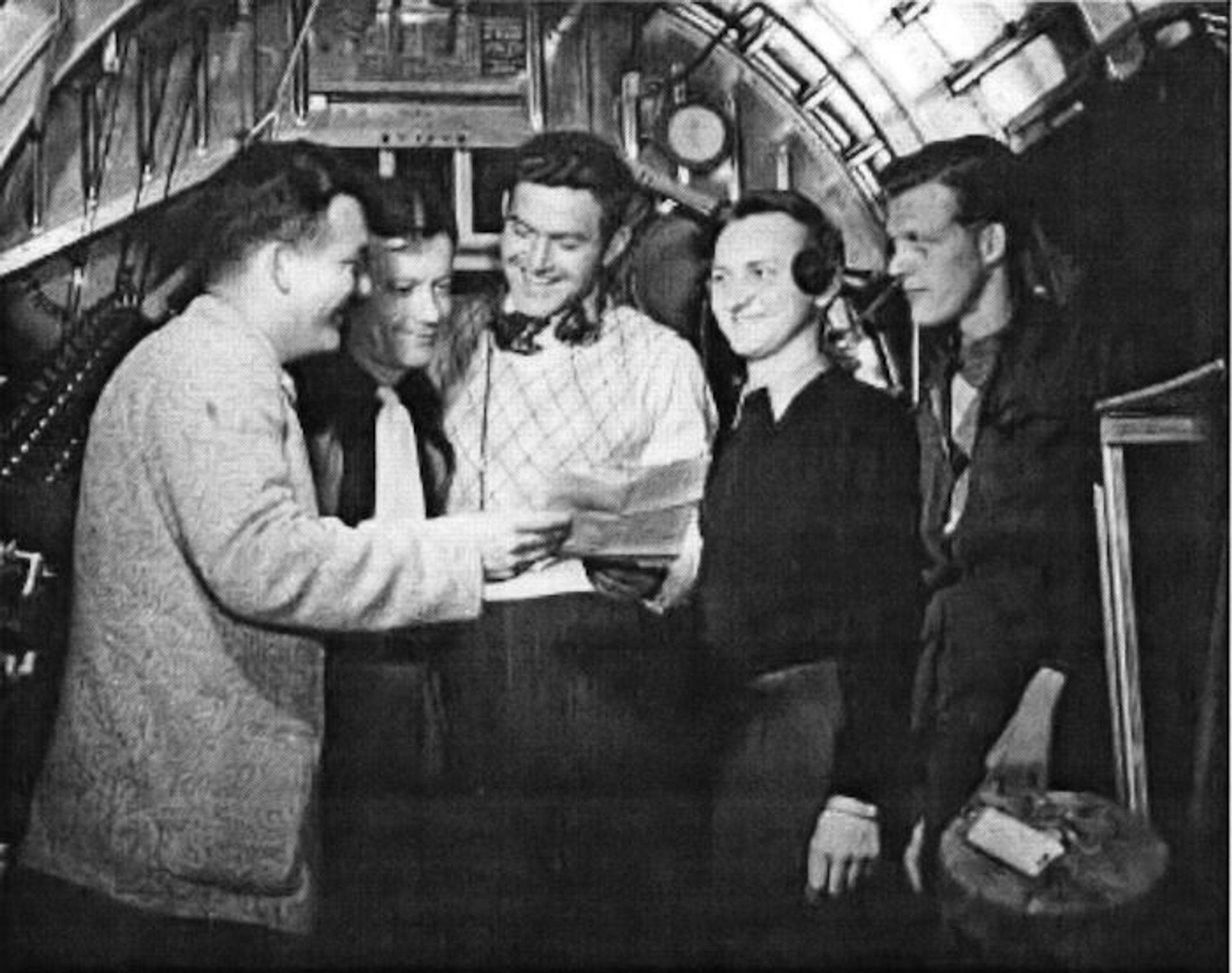
Well, all told it didn’t turn out too bad. Our crew made two trips, and by the middle of June it was all done. We had no uniforms of course, so we flew the ferry trips in our civilian clothes. On the very first trip, after we landed at the base in England, our patched up Lib with peeling paint and leaking oil taxied off the runway to the hardstand. The engines were shut down, and after a few moments, out of the open bomb bay doors erupted this handful of “civilians” dressed in an assortment of clothes, which by any standards reflected only very poor taste. This sight caused a bit of a flap at operations. However, it all calmed down, and the welcoming crowd dispersed, and now there were photographers shooting our pictures – the crew of the first aircraft to be returned from Sweden.
Crew members on board a Liberator in England After their first Ferry flight.
(L-R) Roger Hicks, Bill Haslauer, John Berdar, Joe Sirotnak, Eddie Quarford
(Photo: Sweden After The Flak Dec 1999)
In 1972, I made plans for my first visit to Europe since the war. Of course, I had to include in my itinerary a visit to Sweden, and with my wife and daughter, I arrived in Stockholm on a bright and sunny September day. We had arranged for a rental car to be available for us at Arlanda Airport, and after a night in this pretty city we made our way north.
We arrived in Rattvik late in the afternoon, and checked into a local hotel. The Turisthemmet where we had stayed years before was still in operation, but it was closed now until the ski season began. After settling into our rooms, we went into town and up the main street, where I commenced to search for Klingberg’s Konditori. It was nowhere to be found although I was positive that I was standing directly in front of the building where it should have been. I discovered that the premises were now being used as a gift shop, so I made my way inside. The proprietor assured my way inside. The proprietor assured me that the premises had once housed the Konditori. He informed me that the Klingbergs still lived upstairs where they had always lived. I asked him if he would be kind enough to go upstairs and ask Martin Klingberg to please come down to see me. I also asked him not to tell Martin who was there waiting to see him. After a few minutes this kindly gentleman whom I had not seen in 27 years appeared and from across the room said to me, “Hi, Joe. You got a little fat, didn’t you?”
Oh yes, before we end this story we should address those of you who would be asking, “What about the girls in Sweden?” I can only say, as I have told my wife many times, we were much to busy skiing, bob sledding, plating cards, etc. to really bother very much with the girls. Amen.
A Trip Back to Sweden
by Bob Birmingham
In July of 1997, we were invited to visit Sweden, by the city of Vasteräs, for a reunion of American internees who had spent time in their city during their internment 1943-1945. For a variety of reasons, not the least of which was very short notice, only seven internees with spouses, offspring, and other relatives were able to be there. Nevertheless, the city of Vasteräs wined and dined us for four days in a remarkable fashion.
We were treated to an air show at the airfield where we had been assigned as internees and were honored as special guests. We were given guided bus tours of the city and other tourist attractions of the area. We had lunch at the city hall with the city manager and other councilmen and they presented the ladies with a brass angel produced in the area. We were treated to an evening at the winery and a dinner in a hanger with an aeronautical association. We were given an opportunity to have a two hour ride in the “Concorde” and Marie and I took advantage of that. We were bussed to Stockholm where we visited their original airfield. We visited old town and the VASA, which is a 17th century restored Swedish “Man of War”. This ship, which was under water for 300 years, is certainly one of the wonders of the world. A visit to Stockholm would not be complete without seeing this marvel. The highlight of the trip, however, was a full blown official reception for us at the American embassy which was attended by the American delegation, their wives, and the representatives of several countries, such as Poland, Finland and China. It was a remarkable demonstration of respect for all Americans who had been interned.
The officials of the city of Vasteräs and the friends of American internees who planned and carried out this reunion spared no expense to make us feel welcome and honored.
At the end of the reunion, Marie and I headed for Rättvik. It was a beautiful drive through green forests, past clear lakes and the typical red houses of the area. Not much had changed in this countryside. There were no new housing developments or industrial parks. We stayed at the hotel Lerdalshojden, which is located on the mountain where we once skied. The hotel overlooks the town and Lake Siljan. The landmark church on the banks of the lake was clearly visible. The town is much larger than it was in 1945 and a major highway has been built right through the center of the downtown area, past the railroad station and around the northern end of the lake. The railroad station is now a tourist center. We found the main street where we had spent many hours in Klingberg’s coffee shop as internees. The town has certainly maintained its charm.

After spending two days in Rättvik, we drove to Falkenberg, on the west coast of Sweden, where we had crashed on January 17, 1945. There we checked into the Grand Hotel where our crew had spent our first night in Sweden. The hotel had been enlarged to accommodate a nightclub but not much else had changed. The next morning we were met by our friends Jan-Olof Nilsson (a free lance writer) and Bengt-Arne Karlsson (who works at the Falkenberg Museum). We had been corresponding with these men for several months because they were writing a book about our mission. For the next four days they took us on a whirlwind tour of Falkenberg and the area. We visited the museum where they had a display of things relating to our crash some 52 years earlier. They took us to the crash site some 25 miles outside of Falkenberg. Nothing had changed! It was still open farm country and three of the farms we visited were still occupied by people who had been there in 1945. At the first farm, Gosta Nilsson brought out a life vest which he had picked up on his property right after the crash. I felt that it was my vest since I had landed in a large tree and discarded the vest with my parachute. Gosta agreed to have his picture taken with me holding the vest – but he hung on to it for dear life. It was obvious that it was a valued possession.
At the next farm we meet Einer Karlsson who showed us parts of the plane that he had taken as souvenirs. He showed us things he had made from the parts of the plane, including a device to open the chute on the manure trough in the barn. It was made from a pulley that may have once helped steer the B-24. Einer was also very proud of his souvenirs. Next we visited the farm of Signe Andersson where we were invited in for coffee and cookies (seven kinds of cookies according to Swedish tradition). This is the farm where the plane actually crashed. Signe described how she was baking in the kitchen when she looked out the window and saw several parachutes coming from the sky and then all of a sudden there was a loud crash. The plane landed in her field. She said it was an exciting day for everyone. We will always remember the hospitality of Mrs. Andersson.
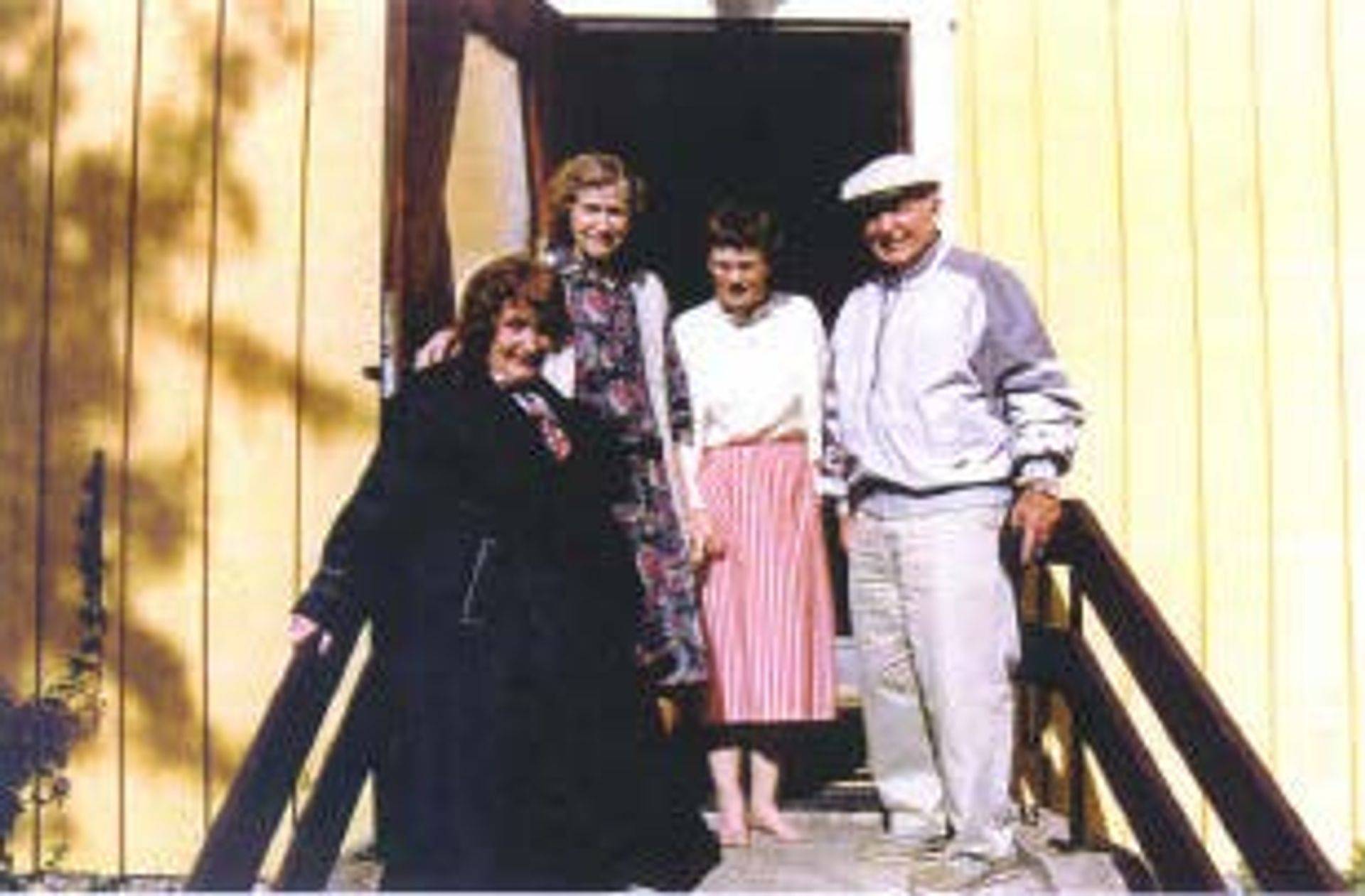
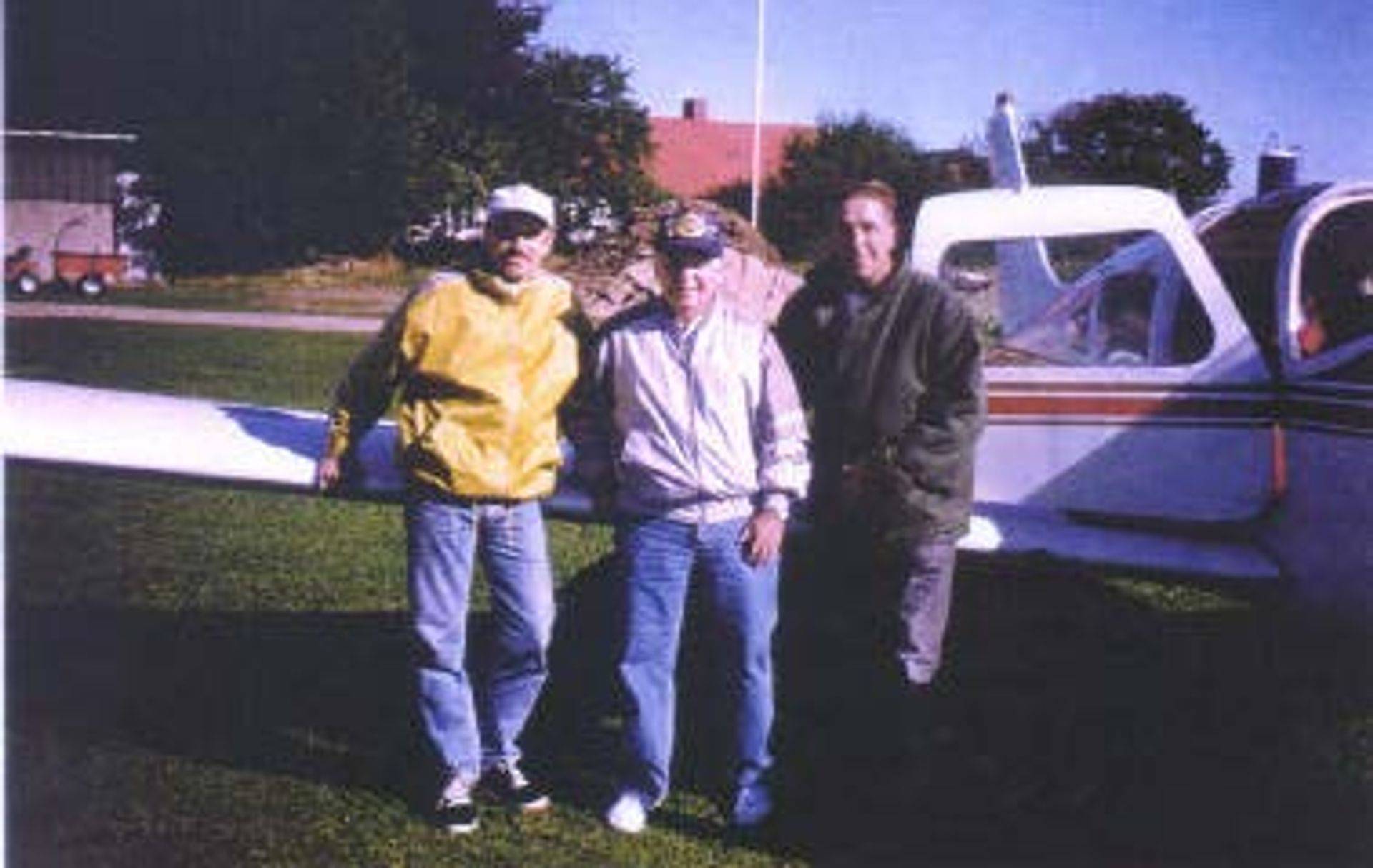
Sweden After The Flak, Vol 1, Issue 4 – December 1999
The next day Jan-Olof had arranged for a friend, Ingvar Johansson, to take me up in his piper Cherokee. Jan-Olof and Bengt-Arne accompanied me on the flight over the area. We flew in from the sea just as we had done 52 years earlier. They pointed out the place where we had crashed and the farms we had visited the day before. What a thrill to see the area just as it was in 1945. Of course I was better able to enjoy the scenery this time.
We spent a wonderful evening at Jan-Olof’s home and another at Bengt-Arne’s home. As you might suspect, this was a trip that we will never forget. We were treated like the war had just ended and we were the heroes. As a result of our visit, there is a little boy in Falkenberg wearing a Green Bay Packers cap to school.
